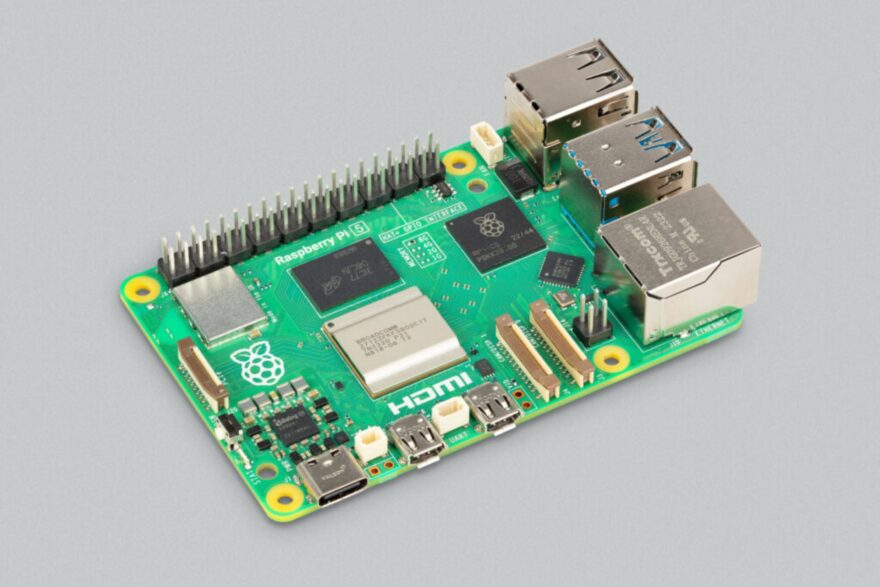Raspberry Pi 5 Has Been Revealed For October Launch
Jakob Aylesbury / 1 year ago

The Raspberry Pi is a tiny computer that is highly useful for a variety of use cases including, education, automation, robotics and servers thanks to its small and low-power design. Today the Cambridge-based Rasbperry Pi foundation has introduced the Raspberry Pi 5 with an October release date.
Raspberry Pi 5
The Raspberry Pi 5 is over twice as fast as its Pi 4 predecessor and is powered by a 2.4GHz quad-core 64-bit Arm Cortex-A76 CPU which features a 512KB per-core L2 cache and a 2MB shared L3 cache. Alongside this is the VideoCore VII GPU with full open-source Mesa drivers from Igalia. This GPU is capable of driving two simultaneous 4K60 HDMI displays. This hardware is paired up with a 32-bit LPDDR4X SDRAM subsystem running at 4267 MT/s.
There are a lot of new features of this Pi but one that truly stands out to me is the introduction of a PC-Style power button which previous models did not feature and is a very nice addition. The board maintains its credit-card-sized footprint but has been redesigned for new elements that work with the new chipset. The board now sports a pair of FPC connectors where the four-pole jack and camera connector used to be. The Four pole composite video and audio jack have been removed but are still available from a pair of 0.1″ spaced pads on the bottom edge of the board. The Gigabit Ethernet jack is back to the right corner after being moved on the Pi 4. Finally, the board features a pair of mounting holes for a heatsink to keep the processor cool, alongside this are JST connectors for the RTC battery, Arm debug and UART and fan with PWM control and tacho feedback pins. Something that should interest enthusiasts is the new PCIe 2.0 x1 interface which will allow for M.2 SSDs to be used on the Pi through a HAT.
Eben Upton Introduces Raspberry Pi 5
Key Features:
- 2.4GHz quad-core 64-bit Arm Cortex-A76 CPU
- VideoCore VII GPU, supporting OpenGL ES 3.1, Vulkan 1.2
- Dual 4Kp60 HDMI® display output
- 4Kp60 HEVC decoder
- Dual-band 802.11ac Wi-Fi®
- Bluetooth 5.0 / Bluetooth Low Energy (BLE)
- High-speed microSD card interface with SDR104 mode support
- 2 × USB 3.0 ports, supporting simultaneous 5Gbps operation
- 2 × USB 2.0 ports
- Gigabit Ethernet, with PoE+ support (requires separate PoE+ HAT, coming soon)
- 2 × 4-lane MIPI camera/display transceivers
- PCIe 2.0 x1 interface for fast peripherals
- Raspberry Pi standard 40-pin GPIO header
- Real-time clock
- Power button

New Accessories
- Case
- Similar to previous Pi cases, this one sports a white and red design but now features new thermal management features including a 2.79 CFM fan with fluid dynamic bearings for low noise and an extended operating lifetime.
- Active Cooler
- The Pi does not feature any heatsink and can run fine for typical client workloads, but those who intend on pushing it a bit further or running it continuously may require the Active cooler with a fan.
- 27W USB-C Power Supply
- The new Pi 5 runs cooler and uses less power than the Pi 4 however with higher performance ceiling there is a possibility for more intensive workloads and other peripherals such as SSDs may demand a more powerful power supply as opposed to the included 15W
- Camera and Display Cables
- An adapter is required for the higher-density pinout of the MIPI connectors which are offered for those who own existing camera and displays. The cables come in 200mm, 300mm and 500mm lengths.
- PoE+ HAT
- With the relocated four-pin PoE header, a new PoE+ HAT is required to support this new location.
- M.2 HATS
- This new Pi comes wiht a PCIE 2.0 interface which allows it to support M.2 drives through the use of M.2 HATS using the 2230 and 2242 form factors.
- RTC Battery
- This battery uses a two-pin JST plug to power the real-time clock on the Pi 5.
Price and Availability
The Raspberry Pi 5 will be released at the end of October for a price of $60 for the 4GB variant and $80 for the 8GB variant.



















